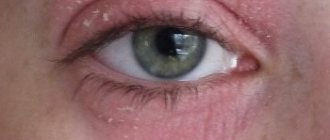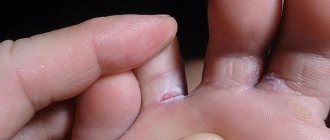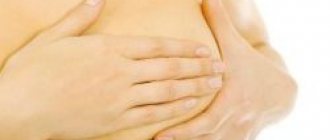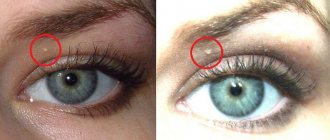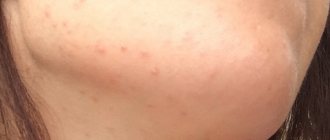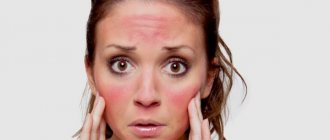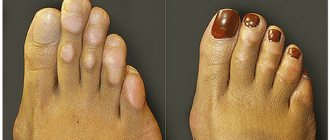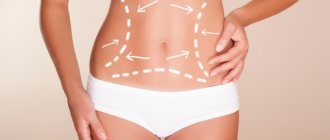Many people have peeling palms and fingers, which not only causes significant discomfort, but in some cases may be accompanied by pain. The lack of prompt measures to restore the skin is fraught with the occurrence of many related skin problems.
Some people do not attach much importance to peeling, considering it an individual characteristic of the body. Meanwhile, it is important to know that if a person’s skin on his hands is very flaky, his palms and fingers are cracking, this may be one of the symptoms of a dangerous disease. Therefore, it is imperative to identify the cause of peeling and take all possible measures to eliminate it.
Causes
The reasons why the skin on the palms and fingers peels are varied, as are the diseases that cause these symptoms:
- Avitaminosis. Epidermal tissue damage occurs when there is a deficiency of vitamins A and C.
- Allergies to chemical detergents, latex products and other cosmetics. In response to irritation, the top layer on the hands peels and cracks.
- Contact dermatitis is a disease of chemical industry workers and anyone who has direct contact with household chemicals, latex gloves (cleaners, housekeepers and all women who clean the house using chemicals).
- Fungal infections are the most common dermatological disease. Girls (dishwashers, saleswomen in meat departments), male construction workers, workers in hot shops and chemical plants often suffer. It appears as weeping lesions, the surface of which is covered with bubbles, spots, and a whitish coating. The epidermis in them peels off and cracks.
- Eczema. There are many varieties, manifesting in different areas with the same symptoms. During an exacerbation, blisters and cracks appear, the skin of the affected areas itches and burns. Scratching leads to secondary infection.
- Psoriasis. The disease is known to be incurable. The appearance of plaques, scales and crusts on the hands and between the fingers is characteristic. The skin becomes rough and causes severe itching.
Why does the skin on the palms of the hands peel?
Hands are one of those parts of the body that are more susceptible to negative external factors than others. It is natural for the skin to renew on them within a month, when the upper layer of the epidermis is replaced almost imperceptibly. If this becomes obvious, then there is definitely a problem in the body.
Symptoms
Skin peeling is manifested by several simple signs - it bursts or cracks, after which pieces of the epidermis appear on the surface, which peel off on their own or can be torn off. Such symptoms affect the fingers as a whole, the surface between them and their pads, the palm itself and its back side.
- peeling;
- burning and itching;
- redness;
- rash;
- pain.
There are many reasons why palms and fingers peel and peel. It all depends on the individual, his skin and occupation. One of the main ones is an allergy to:
- cold;
- caring cosmetics – creams, ointments, soaps, etc.;
- food consumed;
- medicines;
- dishwashing detergent, especially if used frequently without gloves.
Another reason that the skin peels is the lack of proper hand care, including insufficiently deep moisturizing. This is especially true for those who have naturally dry skin. From a lack of vitamins, peeling of the epidermis is also often observed. With a deficiency of microelements, the elasticity of the skin decreases, which can cause cracks.
- prolonged exposure to the sun;
- dry air during the heating season or hot period of the year;
- the habit of constantly scratching your palms, which causes infection in the tissues;
- contacts with cement, dust, earth and other construction work.
A separate reason for peeling skin is a fungus. In this case, the manifestation of symptoms along the edges of the palms is especially characteristic. If the skin on the palms and other parts of the hands peels off, this may indicate some other diseases, such as:
- eczema;
- dermatitis;
- psoriasis;
- lichen planus;
- scabies (the skin peels off on the palms and between the fingers).
In this case, not only does the skin peel off, but also itching, redness and a rash appear. Changing cosmetics will not help here. Treatment is carried out after tests and can only be prescribed by a doctor. In addition to skin pathologies, the reason that the skin peels off is also diseases of the internal organs, parasitic, infectious, etc.:
- lupus erythematosus;
- parakeratosis, hyperkeratosis;
- syphilis;
- staphylococcal infections;
- scarlet fever (fingertips peel off);
- helminthic infestation;
- dehydration (skin peels off, hair becomes dry);
- stress and neurological disorders;
- pathological processes in the pancreas;
- hormonal imbalance;
- reduced immunity.
The reasons why the skin peels off on the palm of one hand are the same as in the case of both hands. Although more often this phenomenon is observed in the event of contact with this hand of some kind of irritant. This is how an allergic reaction to detergent, cosmetics, food, sun or dry air manifests itself. Skin diseases can also be the cause of peeling palms.
The skin is bursting
A more serious problem is skin popping. It may be more painful. Among the external reasons for this phenomenon are:
- exposure to frost;
- aggressive household chemicals;
- unsuitable cosmetics;
- contact with solvents, paints and other compounds used during repairs.
There are a number of diseases that lead to the skin on the palms or arms in general bursting and peeling off:
- eczema;
- avitaminosis;
- fungal infections;
- psoriasis;
- dermatosis;
- metabolic disease;
- hormonal imbalances;
- heredity;
- taking antibiotics;
- inflammation in the body.
Other causes of peeling
- Peeling of the hands and feet may be associated with endocrine disorders, manifested by increased sweating of the palms and interdigital folds, and roughness. Patients with diabetes have flaky and itchy feet.
- A common cause of dry and red hands is chapping in cold weather, the appearance of peeling, and the same changes under the influence of bright sunlight.
- Some infectious diseases are accompanied by detachment of the upper epidermis: lupus erythematosus, syphilis, scabies, lichen, hyperkeratosis (increased cell division).
- There are causes of dryness and flaking associated with uncontrolled use of antibiotics and antihistamines.
- Age-related changes are added: hormonal imbalance, metabolic disorders, reduced immunity.
- Some people periodically experience dry and peeling skin on their hands. The reason is bad heredity. No treatment is required, but constant care is required.
- If you notice that the epidermis is drying or flaking, apply cream, observe and wait. If other symptoms are added, you should consult a dermatologist.
Hand lesions in children
In teenagers, the top layer on the palms of the hands dries out and peels off due to hormonal changes, and not vitamin deficiency, as is often assumed.
! To diagnose peeling skin on the hands of a teenager, it needs to be shown to an immunologist or pediatrician.
The reason for the decrease in the protective functions of the epidermis on the hands of a child may be childhood infectious diseases: measles, scarlet fever, staphylococcus. Often a rash, irritation, itching appears on one hand of a child (usually on the right hand), the cause being a fungus.
Children most often become infected with it because they touch dirty objects on the street. Such diseases are difficult to treat and recur (either disappear or reappear). The photo shows features of fungal infection of the hands.
Patient tactics
In order to select the necessary therapy for the treatment of skin peeling, it is best to consult a therapist, who, in turn, if necessary, will prescribe a consultation with a dermatologist or allergist according to indications.
Be sure to read:
Why do white dots and spots appear on nails - what does this mean?
Additionally, you can conduct a blood test (general, biochemical), as well as allergy tests. If parasitic diseases are suspected, skin scrapings are examined for the presence of skin parasites.
Treatment
Spring vitamin deficiency is identified as a separate disease. For treatment, a course of vitamin complexes and the consumption of fresh vegetables, fruits and dairy products are prescribed. Allergy treatment is carried out with Bepanten, Elocom, Fenistil, the course is supplemented with folk remedies and avoidance of foods such as chocolate, honey, carbonated drinks and others.
When treating contact dermatitis, you should remove all aggressive chemicals, use moisturizers, emollients, ointments and creams, use antibiotics and antiviral medications. Dermatitis and eczema are treated with anti-inflammatory and antiallergic drugs. It is necessary to find out the cause of the exacerbation and follow a diet during such periods.
Fungal diseases are diagnosed after examining the scales under a microscope. Drugs for the treatment of candidiasis: Ketocanazole, Candide, Clotremizan, Fluconazole and others. They are taken for a long time (up to 1 month) until the symptoms disappear. Antifungal ointments are used externally for another week after recovery for prevention.
For mycosis, in addition to pharmaceutical medications, treatment with folk remedies is used in the form of infusions, decoctions, herbal baths (celandine, lavender extract, chamomile), various oils (almond, flaxseed, sage oil). A potato mask moisturizes well and makes your hands soft and tender (raw grated potatoes are applied to the damaged areas, a glove is put on your hand for two hours).
Hand masks are prepared from fermented milk products (sour cream or kefir is applied to the dry surfaces of the palms and covered with a napkin). It is good to wipe the outer side of the brush dehydrated in the sun with cucumber juice. Use an oatmeal scrub to remove the stratum corneum.
Traditional methods
Folk remedies will also help eliminate peeling on your fingers.
The use of traditional methods is possible after consultation with a doctor. If peeling is caused by dermatological diseases, herbal and animal preparations are prescribed as additional means to the main methods of treatment.
Honey
- A mask of honey and glycerin will help get rid of dry skin on your hands. To prepare the medicine, mix honey and glycerin in equal proportions and add 2 tbsp. spoons of water. A homogeneous consistency is applied to the affected areas, left for 15–20 minutes, and then washed off with water.
- A mask of honey, egg yolk and olive oil, taken in equal proportions, nourishes and cleanses the skin of the hands.
- An ointment made from honey (4 tbsp), olive oil (5 tbsp), sandalwood essential oil (5 drops) and turmeric (half a teaspoon) will stop peeling and cracking of the skin. Lubricate your hands with this medicine, put on cotton gloves and warm mittens on top. The duration of the procedure is 30 minutes.
Celandine
- Hand baths with a decoction of celandine are effective.
- An ointment based on dry herbs, vegetable oil and wax delicately exfoliates and softens the skin on the affected areas. To prepare the ointment, dry celandine is poured with water and 250 ml of oil is added. The mixture is brought to a boil, removed from heat and cooled. Add wax to the cooled broth and put it on the fire again until the beekeeping product is completely softened. The finished ointment is stored in the refrigerator.
Animal fat
Animal fats are actively used in cosmetology. Compresses with badger, bear, goose and other fats, applied to washed and dry hands, perfectly cope with the problem of peeling fingers.
Oils
Before going to bed, it is advisable to moisturize the skin of your hands with almond, olive, linseed or peach oils. Grapeseed oil will relieve redness. To achieve maximum effect, rub the oil into the skin with light massage movements for 5–7 minutes, then put on cotton gloves.
Prevention
To avoid unpleasant symptoms on the skin of the palms and fingers (itching, peeling, cracks), you need to: moisturize them daily, exfoliate dead cells, wash your hands with cosmetics containing glycerin, take baths with herbal infusions, give preference to hypoallergenic cosmetics. It is necessary to include the following components in the diet: greens, nuts, cereals, cereals, vegetable oil, and take complexes of vitamins and minerals.
Remember! Hands, our main helpers, need constant care, perhaps even more than the face and other parts of the body.
Hands should be protected from temperature changes. In cold weather, be sure to wear warm gloves or mittens, avoid contact with the ground and cement during construction work, and if necessary, wear protective gloves. Dishwashing detergents should be gentle, do not forget rubber gloves (if you are not allergic to them!).
Severely irritate the skin of the hands and feet, mechanical injuries lead to cracks, as well as burns and hypothermia. If dryness on the inside of your palms appears as a result of dehydration, you should increase the amount of water you drink to cope with it.
Etiology
The skin on the hands often dries and cracks under the influence of non-pathogenic factors, including:
- vitamin deficiency (dryness, skin peeling off fingers, bruises);
- weather conditions (chapping of the skin in cold weather is fraught with drying out of the sensitive epidermis, the appearance of peeling and deep cracks);
- improper skin care (washing hands too often, using low-quality care and cleansing cosmetics, as well as daily cleaning, washing dishes, washing clothes by hand without special gloves and using aggressive household chemicals leads to the abrasion of the protective layer of the epidermis).
In addition to the fact that under the influence of these factors the skin loses its healthy and well-groomed appearance, due to the thinning of its natural protective barrier, the gates open for all kinds of pathogenic microorganisms. The risk of infectious, fungal or viral infection increases several times.
Also, the skin on the hands cracks until it bleeds, drying out and becoming irritated due to the development of such pathological conditions of the body:
- Mycosis. People of different ages, gender and nationality are susceptible to fungal infections of the skin of the hands by dermatophytes and candida. The source of the disease in most cases is infected skin of the feet, from the surface of which spores of the pathogenic fungus spread throughout the human body. Characteristic manifestations of mycosis on the hands are dryness, irritation and peeling of the skin between the fingers, a burning sensation and itching in the damaged areas. With candidiasis, these symptoms are accompanied by a whitish coating with a sour odor, weeping, the formation of yellowish or white spots on the nail plates and a change in their shape, caused by the penetration of fungal spores into the thickness of the nail.
- Dermatitis. Drying and cracking of the skin on your hands can be caused by allergic or contact dermatitis. For the first type of disease, which develops immediately after direct contact of the skin with an allergen, the characteristic symptoms are the accompanying inflammatory process, hyperemia and swelling of the affected area. Allergic dermatitis can develop without direct contact of the skin and the irritant; its indirect exposure (oral intake of certain groups of medications, food, etc.) is sufficient. This type of disease is manifested by redness, swelling and itching of the skin, the formation of small water bubbles with liquid on the fingers. In advanced cases, the skin on the palms may peel off.
- Eczema. Severe itching, hyperkeratosis, dryness and flaking, swelling and weeping of the skin usually react to the development of eczema. In most cases, the symptoms of the disease in chronic form manifest themselves in the form of a rash on the palms and fingertips. During the period of exacerbation of the pathology, large cracks may form on the skin of the palms, in the folds between the fingers, thickening and excessive pigmentation of the affected skin, provoked by constant scratching of itchy foci of eczema.
- Exfoliative keratolysis. In women and men at a young age, exfoliative keratolysis often occurs, in which the skin on the hands becomes very dry and flaky, especially in the hot summer season. A predisposing factor to the development of the disease is the use of soaps, solvents or detergents with aggressive components in the composition. The first symptoms of the disease are small air-filled blisters that are localized on the fingers or the surface of the palms. Noticeable itching may occur only in rare cases. In the pathogenesis of exfoliative keratolysis, there is a strong tendency towards relapses occurring as soon as possible after remission. This process is usually accompanied by the formation of large cracks in the interdigital folds and on the palms.
- Cold urticaria. The skin of the hands is often exposed to aggressive external factors (frost, cold wind and water, dampness, etc.). Against the background of such cold irritation, an allergic reaction develops, the characteristic manifestations of which are red spots, swelling, the formation of blisters, dryness and peeling of the skin exposed to low temperatures. Allergy symptoms make themselves felt in the near future (usually within the first 10-20 minutes) after contact with external irritants.
It also cannot be ruled out that drying and cracking of the skin on the hands may act as a dermatological manifestation of diabetes mellitus. Patients experience dry skin, local hyperkeratosis on the palms, and wrinkling of the fingertips.
